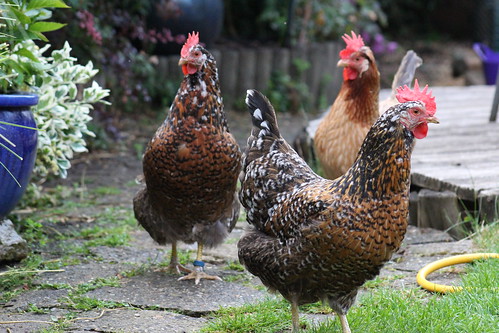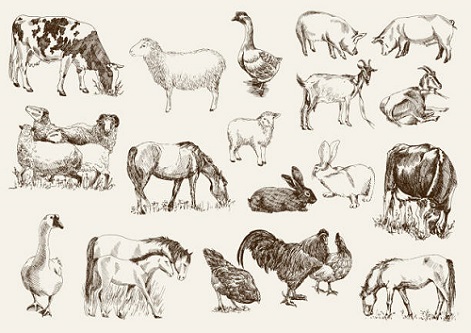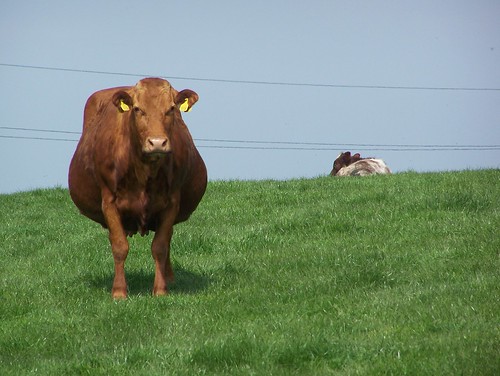Many gardeners struggle with an ongoing battle against common garden pests that destroy crops and transmit diseases. Slugs, snails, caterpillars, aphids, and beetles can quickly overrun vegetable and flower beds if left unchecked. While chemical pesticides aim to eliminate pests, they have harmful environmental and health impacts.
Sustainable practices that reduce or eliminate the need for pesticides are better long-term solutions for the garden, the gardener, and the environment. Natural biological controls provide an eco-friendly alternative to dependence on chemicals.
One very effective natural predator that many gardeners don’t consider is the humble chicken. As foragers, chickens will eagerly search gardens for their favorite snacks – invertebrate pests like slugs, snails, and insects.
The Garden Pest Menace
Types of Common Garden Pests
1. Aphids
Aphids are soft-bodied insects that come in many colors but often appear pale green, black, or gray. Their tiny size makes them difficult to spot, especially when clustered on the undersides of leaves. While aphids use their piercing-sucking mouthparts to feed on plant sap, they also inadvertently transmit harmful viruses between vegetables and ornamentals. Certain species have wings and can “fly” to infest other parts of the garden rapidly.
2. Slugs and Snails
Slugs are essentially shell-less snails that survive despite great vulnerability due to their highly efficient mucus production and feeding. Both slugs and snails might each consume the equivalent of their body weight in vegetation every night. Their slime trails pose another issue, providing an environment where disease spores can survive to infect other plants.
3. Caterpillars
Most gardeners are familiar with the gorgeous butterflies that emerge from caterpillars’ transformations. However, some caterpillar species consume plants voraciously and become true agricultural pests. For example, cabbage white butterfly and tomato hornworm caterpillars can strip entire heads of cabbages or tomato plants of their foliage within a few days if not addressed.
4. Beetles
While some beetles play beneficial roles in gardens, several invasive species have become established to threaten homegrown crops. Japanese beetles, for instance, have spread rapidly across the eastern U.S. since their accidental introduction in 1916. Their swarming behaviors allow reproduction into the millions each season, easily overwhelming unprotected plants through feeding damage.
The Damage They Cause
Crop Destruction
At population peaks, voracious pests like coddling moths or tomato hornworms can consume every fruit or leaf available in merely a single night. This full defoliation severely weakens plants or prevents any crop yields.
Disease Transmission
Many insects, slugs, and snails harbor pathogenic microbes in their digestive systems without visible signs of illness. But as these pests graze from plant to plant, their mouthparts and bodies unwittingly deliver viruses, bacteria, or other diseases into new hosts. Once established, such infections can devastate entire gardens for several seasons.
The Chicken – Nature’s Pest Control Expert
Chickens as Natural Predators
Foraging Behavior
Left to their natural inclinations, chickens spend each day performing behaviors essential to their survival. As ground-dwelling birds, they constantly peck and scrape at the soil and foliage underneath in search of tasty invertebrates to consume. This instinctual foraging makes chickens ideally suited to naturally control garden pest populations.
Pest Preferences
Studies have shown chickens have no prejudice when it comes to invertebrate snacks. They eagerly seek and devour common pests like slugs, snails, caterpillars, insects, and their eggs. These garden invaders are highly palatable to chickens due to their soft bodies and inability to escape once noticed. A single chicken can easily eat 5-10 slugs or 30-50 snails in just one day of foraging!
Benefits of Using Chickens for Pest Control
Chemical-Free Pest Management
By allowing chickens to control pests naturally with their built-in prey drive, gardeners can avoid using pesticides with negative health, environmental, or resistance impacts over time.
Reduced Pest Population
With chickens constantly on patrol, far fewer pests will survive to adulthood and reproduce and consume plants. Their persistent foraging helps maintain pests at low, less damaging levels.
Fertilization of the Garden
As chickens search, they fertilize the soil with their natural waste products. This boosts nutrient density without any added chemicals or expense to the gardener.
Chicken Breeds for Pest Control
Breeds Ideal for Pest Management
Rhode Island Reds
A tried-and-true American breed, Reds make excellent pest hunters. Their tendency to roam allows thorough coverage of large garden areas. Reds’ bold red plumage also allows easy spotting for headcounts.
Australorps
Originally from Australia, Australorps have a no-nonsense “all business” attitude. Their abilities to withstand varied weather suit them to gardens in different climates throughout the season.
Sussex
Known for grazing pastures, Sussex has the steadfast personality required to proactively search the garden daily without tiring. Their dappled yellow and grey feathers help camouflage among foliage while spotting prey.
Chicken Characteristics to Look For
Vigilant Foraging
Chickens hunt by sight, so birds persistently scanning the area trick pests into complacency before discovery. These chickens maximize pest consumption.
Friendly Temperament
Docile birds feel less threatened by human presence to allow supervision, training, and handling for inspection without stress. This improves rapport with both chickens and gardeners alike for successful partnerships.
Creating a Chicken-Friendly Garden Environment
Fencing and Coop
- Install secure fencing around the entire area the chickens will access to keep them safe from predators. Bury the bottom 1-2 feet or use a hardware cloth to prevent digging under.
- Build or buy a sturdy coop that protects from weather and predators. Have at least 4 square feet per chicken inside.
Garden Layout
- Divide your garden into separate areas – one for chickens and one just for plants. Use fencing or barriers to keep chickens out of plant beds.
- Chickens will dig up newly planted beds and eat seedlings. Have established plantings before introducing chickens.
- Provide shaded dust bathing areas for chickens away from plants and vegetable gardens.
Ensuring Safety for Chickens
Predator Protection
- Use predator-proof fencing and coops. Bury fencing, use small mesh, and use wire under coops.
- Lock chickens securely in the coop at night. Close pop holes.
- Remove hiding spots like piles of wood or debris where predators can hide.
- Use motion sensor lights and predator-proof runs when chickens are out of the coop.
- Consider getting a livestock guardian animal like a dog to protect free-ranging chickens.
Preparing Your Garden for Chickens
Creating a Chicken-Friendly Garden Environment
Fencing and Coop
Before introducing chickens, install predator-proof fencing around the designated garden area. Provide a sheltered coop or mobile house for protected roosting at night and as a safe home base.
Garden Layout
Remove toxic plants to designated non-chicken areas. Prune lower branches and trim tall plants/bushes to create clear sight lines for chickens’ pest-hunting abilities. Mark off-limits plant sections for initial supervision periods.
Ensuring Safety for Chickens
Predator Protection
Fencing should bury at least 6 inches underground and extend 3+ feet above ground to deter burrowing/climbing predators. Consider covering the top of the coop for aerial protection. Secure latches prevent wild animal or dog entrance.
Training Chickens for Pest Control
Teaching Chickens to Identify Pests
Reward Positive Identification
When chickens notice and peck tiny slugs or insects, provide real-time praise and a small food treat. This positive reinforcement aids pest recognition and encourages chickens to hunt proactively.
Implementing Pest Control Routines
Scheduled Patrol Periods
Dedicate regular 30-minute sessions like mornings for chickens to patrol and feast on pests under supervision. This establishes routines for purposeful garden time.
Locking Up at Other Times
Secure chickens safely away when not actively foraging to avoid accidental damage from unchecked pecking curiosity.
Supervising Chickens in the Garden
Guiding Inexperienced Chickens
New pest patrol partners may require guidance to focus on sanctioned snacks instead of plant tastes. Redirect energy with encouragement toward pests as desired behaviors.
Sustainable Gardening Practices
Companion Planting with Chickens
Deterring Pests Naturally
Interplanting alliums and flowers chickens don’t eat deters some insect pests through smell and visual disruption. Chickens help further by consuming any remaining.
Managing Garden Waste
Composting Trimmings and Droppings
Grass clippings, pruning debris, and chicken manure combined create nutrient-rich compost to amend soil without chemicals.
Organic Gardening Principles
Building Healthy Soil Biology
By encouraging soil microbes through compost additions, the ecosystem supports plant defenses against pests and reduces the need for fertilisers.
Tips for Optimal Results
Ensuring a Balanced Diet for Chickens
Whole Grains and Proteins
A diet mimicking their natural inclinations keeps chickens healthy and motivated predators. Feed a mixture of whole grains, protein sources, grit, oyster shells, and clean water.
Monitoring Chicken Health
Daily Check-ins
Ensure no injuries have occurred from miss-targeted pecks. Watch flock energy levels and appetite as health indicators to address any potential issues swiftly.
Rotating Garden Areas
Consistent Foraging Grounds
Move shelters periodically to divide the garden into sections individually scoured before the flock moves on. This avoids boredom and maintains high pest consumption.
Challenges and Solutions
Dealing with older chickens
Establishing Boundaries
Redirecting over-curious chickens from protected plants with calm clucks while providing approved areas and snacks prevents damage while maintaining positive relationships.
Chicken-Friendly Pest-Repellent Plants
Aromatic Groundcovers
Planting herbs like rosemary, thyme, and marigolds around vulnerable crops utilizes natural defenses while doubling as forage to satisfy chickens’ appetites.
Seasonal Considerations
Addressing Winter Sluggishness
Additional high-protein treats boost energy for pounding patio pests hiding under leaves. Sheltered areas still allow gentle encouragement outside daily.
Providing problem-solving techniques empowers organic practices’ success. Kind supervision helps pest patrollers adapt. Please let me know if any clarification would further assist sustainable gardeners.
The Environmental Impact
Reducing Chemical Pesticide Usage
Avoiding Toxic Runoff
By naturally managing pests, chemicals don’t contaminate soil, groundwater, or waterways. This protects ecosystems and communities’ health long-term.
Promoting Biodiversity
Supporting Beneficial Insects
Spared from sprays, good bugs like ladybugs and lacewings aid plant defenses against problem populations. Diverse life enriches soil fertility.
Beyond Pest Control: Additional Benefits of Chickens
Fresh Eggs and Meat
Nutritious Home Provisioning
Aside from their garden contributions, flocks provide delicious protein. Collected eggs sustain families for weeks with zero packaging waste.
Garden Fertilization
Natural Nutrient Redistribution
Through foraging and scratching, chickens aerate the soil and distribute manure to nourish plants organically without synthetic inputs.
Education and Family Involvement
Life Lessons Beyond Pest Services
Children learn responsibility for caring for chickens. Families bond over colorful fowl companions amplifying the garden experience for all ages.
Conclusion
Chickens serve as excellent organic allies for whole-system pest management in home gardens. Their enthusiastic foraging reduces populations while enriching soil fertility naturally. With patient guidance integrated into the greater approach, flocks learn roles benefiting all. Establishing harmonious multi-species environments mirrors nature’s balanced design. For gardeners dedicated to sustainable practices, chickens offer pest protection as well as livelihood, nutrition, and education. Adopting respectful stewardship across living communities cultivates bountiful harvests and legacies for future generations. Together, may we thoughtfully glean from the land as she provides.


